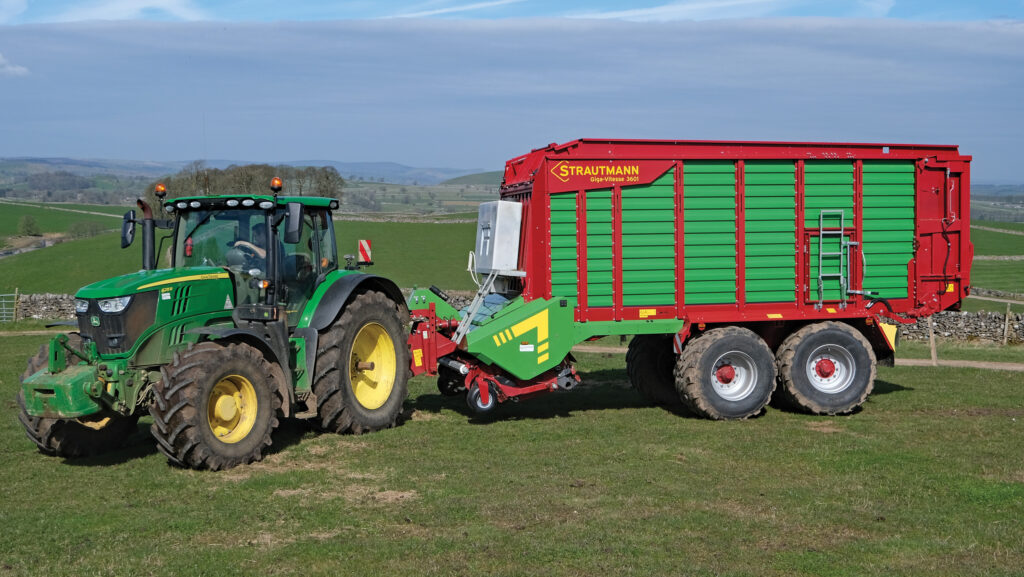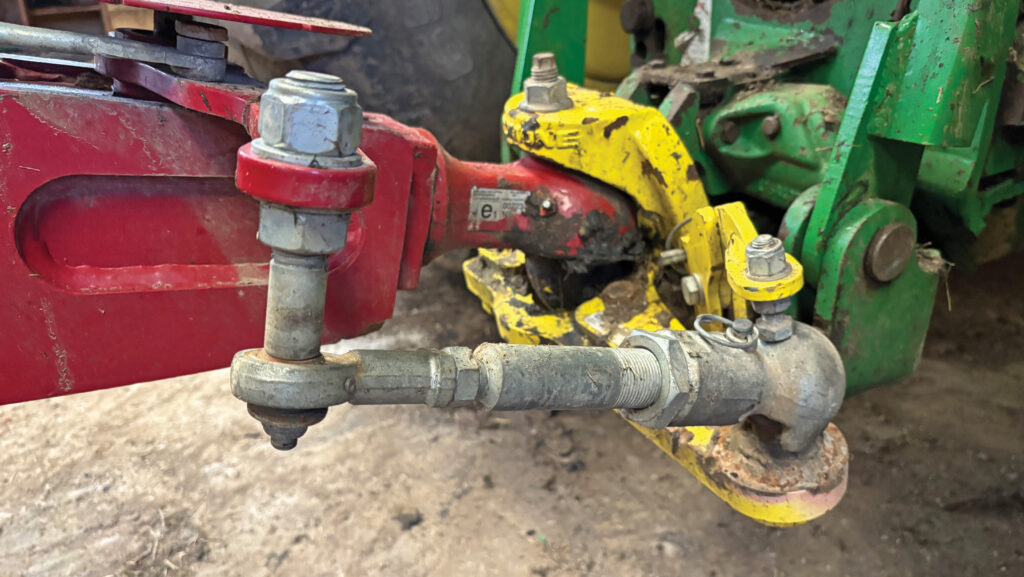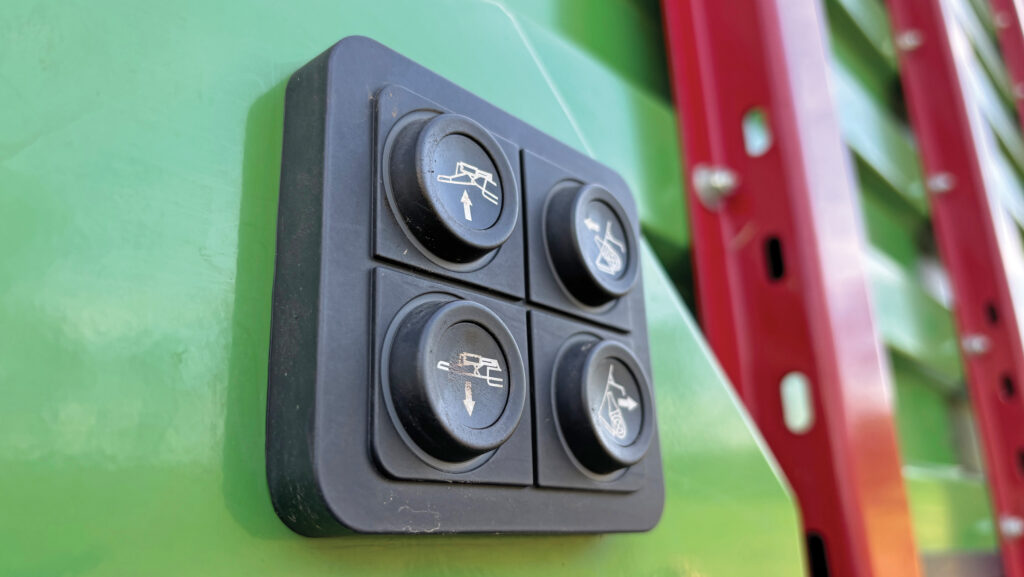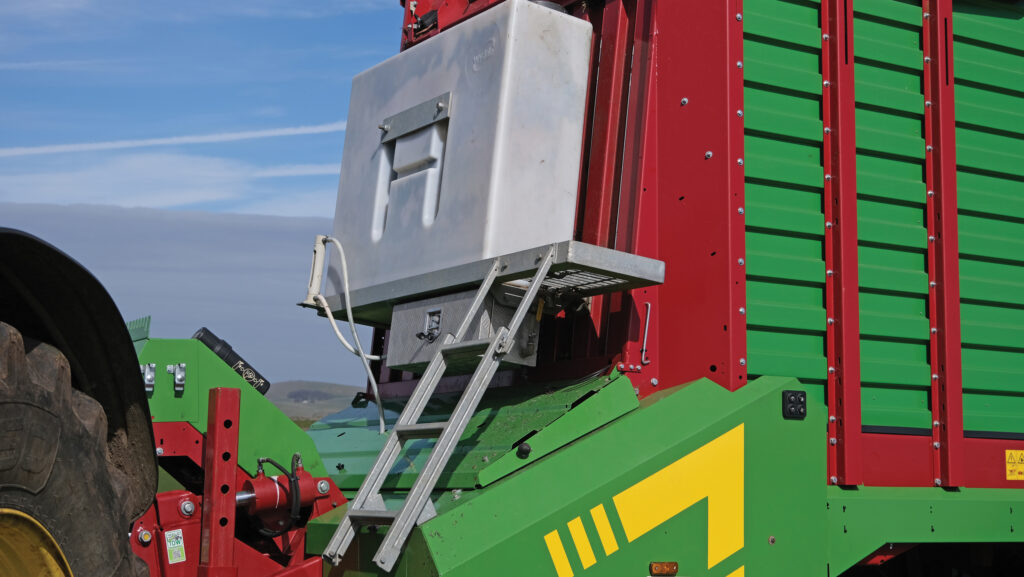Driver’s view: Andrew Whitelaw’s plastic-tined Strautmann Giga-Vitesse 3601
 Strautmann Giga-Vitesse 3601 © James Andrews
Strautmann Giga-Vitesse 3601 © James Andrews As the mid-spec model in Strautmann’s forage wagon line-up, the Giga-Vitesse packs plenty of high-end features without the added expense of pivoting headboards found on fancier Magnon machines.
At the front end, buyers get the choice of a regular steel-tine camless pick-up or the firm’s plastic tined Flex Load system, which promises fewer breakages, better contour following and faster tine changes.
See also: Buying a trailed forage harvester – the options
Between this and the feed rotor sits a “continuous flow system” roller that evenly distributes the crop across the entire width of the chopping unit.
Grass then passes through 45 double-sided knives that give a theoretical cutting length of 35mm.
A trio of Giga-Vitesse machines is in the offing, ranging from the 42cu m 4401 to the 34cu m 3601, the latter being the tool of choice for Derbyshire contractor Andrew Whitelaw.
He runs three such machines – two new and one second-hand – which he uses to chop 2,000ha of grass within a 25-mile radius of his base at Alstonefield, Derbyshire.

Andrew Whitelaw © James Andrews
Strautmann Giga-Vitesse 3601
- Year: 2024
- Capacity: 34cu m
- pick-up width: 2m
- Knives: 45
- Chop length: 35mm
- Weight: 9t
- Tyres: 710/50 R26.5 BKT and 800/45 R26.5 BKT
- Price paid: £93,000 and £99,500
Why a forage wagon?
I started out working for other local contractors, but was keen to branch out on my own and had been looking out for opportunities.
Forage wagons soon came to my attention as no one was running them in the area back in 2015 and it was a self-contained, one-person job.
So, I lined up some potential customers, looked at what wagons the local dealers had for sale and shelled out for a brand-new Pottinger 5100 Torro.
It turned out demand was bigger than I expected, so I soon found myself needing a second machine and driver.
To keep the finance payments down I went second-hand this time, but stuck with what I knew and got the same model again.
There were some good features on the Pottinger wagons, but having never done the job before, I made some rookie mistakes.
The biggest of these was opting for auto knife sharpeners.
Not only were these fairly poor at sharpening, but they caused loads of metal filings to get into the knife rollers and wear them out.
Halfway through the second season, a complete refurb of the bank was required.
Thankfully, the dealer footed the bill for the parts, but we did all the labour and it was a big job when we were desperate to get chopping.
Why Strautmann Giga-Vitesse 3601s?
After the knife roller debacle, I was keen to find a more durable wagon and, having asked several other contractors, Strautmann came out top of the list.
In 2018, the two Torros were swapped for a pair of Giga-Vitesse 3601s and I’ve stuck with them ever since.
The reason for running the 3601s in particular is that they have decent capacity without being too large to get down narrow lanes and through tight gateways.
We’ve demoed the higher-spec Magnon with its pivoting headboard, but it’s a lot more expensive and you lose the best spot for mounting an additive tank.
I’m currently running three machines: two new ones and a second-hand 2015 model that acts as a bit of a backup.

Plastic pick-up tines are tougher than steel alternatives © James Andrews
Strautmann Giga-Vitesse 3601
- Year: 2024
- Capacity: 34cu m
- pick-up width: 2m
- Knives: 45
- Chop length: 35mm
- Weight: 9t
- Tyres: 710/50 R26.5 BKT and 800/45 R26.5 BKT
- Price paid: £93,000 and £99,500
Any extras?
The two new models arrived last spring. One is fairly standard, while the other has forced steering, larger 800 tyres and a galvanised steel rather than wooden floor.
The forced steering is a game changer and something I’ll go for on all wagons from now on – it should be standard really.
The big benefit is during reversing as the wheels on the rear axle turn with the tractor so there’s no strain on the running gear.
In contrast, you lock the rear axle solid on passive steer models, which puts a huge amount of pressure on the machine when backing around corners.
You can often hear them groaning under the strain and we did have some cracks in the chassis on one of our previous wagons.
The larger tyres were another nice upgrade as they significantly improve traction and stability on steep sidehills.
One thing I did opt for on both is flex-load pick-ups, which have rubber rather than metal tines. These have been fantastic as they don’t bend or get strained when they hit hard objects.
Plus, if you do need to change one, it’s so quick and easy.

Forced steering puts far less strain on the chassis © James Andrews
How much work does it do?
Each of the new wagons does about 800ha/year and I usually keep them for three years before upgrading.
By this time, they’ve done about 3,000 loads, they need new knives and the tyres are getting low, so I move them on before I have to spend a lot on repairs.
For the backup machine, I went for an older 2015 model as I knew this had already been given an overhaul.
How have they performed?
All the Strautmann wagons I’ve had have gone well, and I’ve rarely had any major breakdowns.
The only one that sticks in my mind is a main rotor bearing going on one machine in the third season. I saw some smoke coming out of the side panel and then realised it had collapsed.
It was easy to replace though, and I haven’t had this problem on any others.
What’s grass quality like?
The Giga has 45 knives that give a chop length of 35mm, which I think is about right. If you want to go any shorter than this, you might as well get a self-propelled machine in.
Consistency is good when it’s set up right, and customers say they get less waste on the clamp than they do when they’ve had a precision chopper in.
But it all hinges on having sharp knives. We have two sets for each wagon and they always start each day with one fresh side.
Not only does this make a massive difference to the quality of the silage, but it reduces the power requirement and means we use less fuel.
For the past five years I’ve been using a Claas Aqua Non Stop sharpener, which dramatically reduces the workload.
At £14,000 it was a significant investment, but when I worked out the cost per acre to be about 60p over the five years I had it on finance, it seemed a sensible move.
I wouldn’t be without it now as it makes the knives like new and has saved a huge amount of time.

External buttons make it easy to access the knife bank © James Andrews
What could be improved?
The big thing for me is that you can’t order a factory-fit additive system.
Everyone uses the stuff, so it seems mad that we have to muck around with retrofit units and try and find somewhere to fit the tank.
We’ve been trying to perfect our setup over the years and have now got it working well.
It consists of a galvanised steel frame, complete with integrated folding steel ladder, that bolts to the front bulkhead and carries a 400-litre tank.
This is piped to nozzles above the pick-up with a small pump to dispense the liquid, a rotary valve to switch the flow on and off, and a float gauge to show the application pressure/rate.
We’ve been using Selmech switchgear, but I’m in the process of putting my own together using switches and a motor controller from Amazon, which are a fraction of the price.
The auto-load system also needs improvement as this is the only thing that was better on the Pottinger wagons.
It never seems to get the timing right so we always operate it manually, shifting the bed back as soon as the tractor starts struggling.
Would you buy another?
I think Strautmanns are the best wagons out there, so I wouldn’t have anything else.
Hopefully, I’ll be in a position to upgrade these two in a couple of years’ time – it just hinges on whether second-hand values hold up and new prices don’t get silly.
Two things that will be top of my shopping list are the flex-load pick-up and forced steering.
But I’d probably have the bigger tyres too, and I would be tempted if they offered an integrated additive setup.

Retrofit additive system © James Andrews
Likes and gripes
Likes
- Strong and durable
- Consistent chop quality
- Plastic pick-up tines
- Forced steering rear axle
Gripes
- No integrated additive system
- Autofill could work better
- Forced steering should be standard

